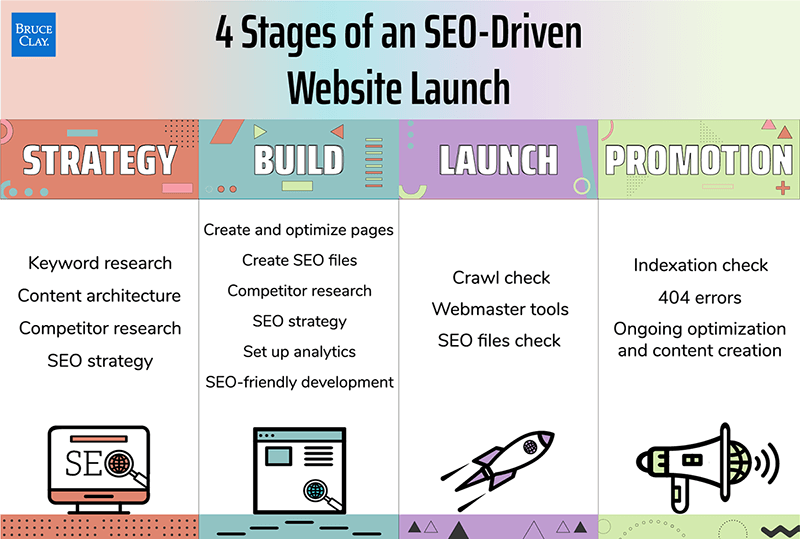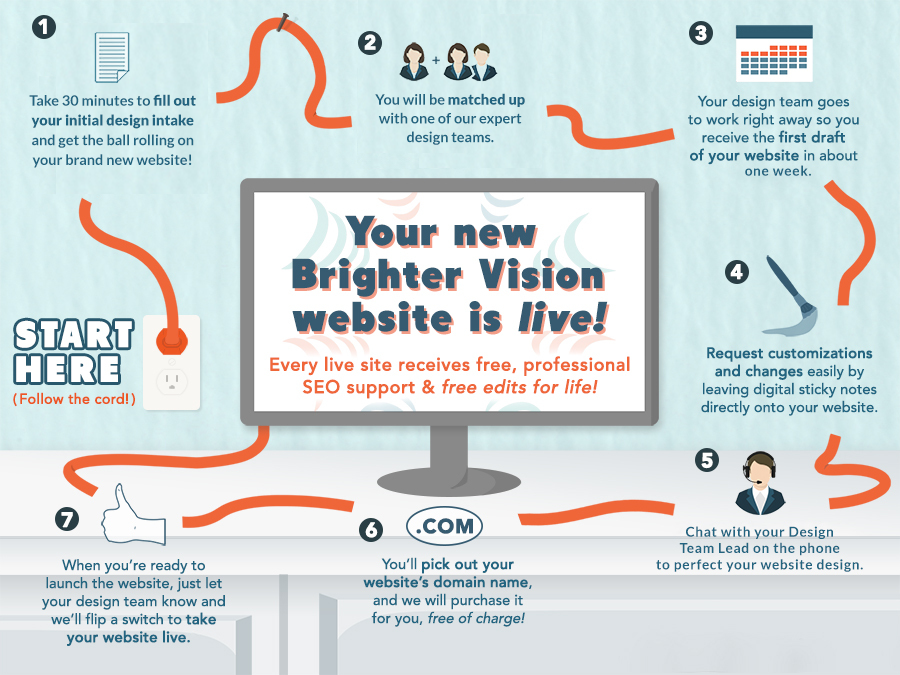Unsure how launching a new website will affect your SEO? Discover the surprising impact and how to navigate it successfully.

Image courtesy of via DALL-E 3
Table of Contents
Launching a new website is an incredibly exciting endeavor! It’s like opening the doors to your very own digital world where you can share your ideas, creations, and stories with the online community. However, just like in the real world, where you want people to find and visit your store, in the digital realm, you want people to discover and explore your website. This is where the magic of search engine optimization (SEO) comes into play!
Why Launching a New Website is Exciting
Imagine having a blank canvas in front of you, ready to be filled with colors and shapes that reflect your personality and interests. That’s what creating a new website feels like! You get to choose the colors, the layout, the content – everything that will make your site uniquely yours. It’s a chance to showcase your talents, share your passions, and connect with people from all over the world!
What is SEO?
Now, let’s talk about SEO. SEO stands for search engine optimization, and it’s like a secret code that helps search engines like Google understand what your website is all about. By using the right keywords, creating valuable content, and making your site user-friendly, you can improve your SEO and make it easier for people to discover your website when they search for related topics online.
Why You Need to Think About SEO
Think of SEO as your website’s ticket to the top of the search results page. When someone types a question or a topic into a search engine, you want your site to be one of the first ones they see. By optimizing your site for SEO, you increase the chances of getting more visitors, more views, and more opportunities to share your message with the world. So, it’s definitely something worth thinking about as you launch your new website!
Step 1: Choose a Good Domain Name
What is a Domain Name?
A domain name is like the address of your house, but for your website. It’s what people type into their web browsers to find your site. A good domain name is easy to remember and tells visitors what your website is about.
How to Choose a Good Domain Name
When picking a domain name, think about what your website is for. If you’re making a site about cooking, a domain name like “BestRecipes.com” would be a good choice. Make sure it’s not too long or complicated, so people can easily type it in.
Mistakes to Avoid
Avoid using numbers or hyphens in your domain name, as they can confuse visitors. Also, try to stay away from using trademarks or famous brand names, as you could get into legal trouble.
Design Your Website with SEO in Mind
When you’re creating a website, it’s crucial to think about how users and search engines will navigate it. Good design not only makes your site visually appealing but also helps visitors find what they’re looking for quickly. Search engines like Google also prefer websites that are well-organized and easy to navigate. So, make sure your website design is user-friendly and intuitive.
SEO-Friendly Features
To improve your site’s SEO, consider implementing SEO-friendly features such as clear navigation, descriptive URLs, and optimized images. By including keywords in your page titles, headings, and meta descriptions, you can help search engines understand what your website is about. Additionally, creating a sitemap can make it easier for search engines to crawl and index your site, boosting your SEO rankings.
Common Design Mistakes
There are some design pitfalls that can harm your website’s SEO. Avoid using too many large images or flash animations, as they can slow down your site’s loading speed. Make sure your website is responsive and mobile-friendly, as more and more people are using smartphones and tablets to browse the web. Lastly, steer clear of cluttered layouts and confusing navigation, as they can frustrate users and hurt your SEO.
Step 3: Create Quality Content
Quality content is like a tasty treat for your website visitors. It’s the information, stories, and ideas you share on your site that make people want to stay and explore more. When you create quality content, you’re giving your visitors something valuable and interesting to read, watch, or listen to.

Image courtesy of www.bruceclay.com via Google Images
Tips for Writing Great Content
If you want to write awesome blog posts or articles for your website, here are some simple tips to follow:
1. Be clear and concise: Make sure your writing is easy to understand and gets straight to the point so that your readers don’t get lost.
2. Tell a story: People love stories, so try to weave a narrative into your content to keep your readers engaged.
3. Use catchy headlines: A good headline can grab someone’s attention and make them want to click to read more.
Using Keywords
Keywords are like secret codes that help search engines, like Google, understand what your content is about. When you use keywords that are relevant to your website’s topic naturally in your content, it can help improve your SEO. Just remember, don’t overstuff your content with keywords – it should flow smoothly and make sense to your readers.
Step 4: Optimize Your Images
When you’re building a website, images play a crucial role in attracting visitors and making your site visually appealing. But did you know that they can also impact your site’s SEO? Optimizing your images can not only enhance your website’s performance but also improve its search engine rankings. Let’s dive into why image optimization matters and how you can do it effectively.
Why Image Optimization is Important
Large, unoptimized images can slow down your website’s loading speed, which can have a negative impact on user experience and SEO. Search engines like Google prioritize websites that load quickly and provide a seamless browsing experience for users. By optimizing your images, you can ensure that your site loads faster, improving its chances of ranking higher in search results.
How to Optimize Images
Optimizing your images doesn’t have to be complicated. Here are a few simple steps you can take to optimize your images for better SEO:
1. Resize your images to the appropriate dimensions for your website. Large images can be resized using tools like Photoshop or online image editors.
2. Compress your images to reduce their file size without compromising quality. There are various online tools like TinyPNG or Compressor.io that can help you compress your images effectively.
3. Add descriptive alt text to your images. Alt text helps search engines understand what the image is about, improving your chances of ranking for relevant keywords.
Tools to Help with Image Optimization
If you’re looking for easy-to-use tools to help you optimize your images, here are a few recommendations:
1. TinyPNG: This tool allows you to compress PNG and JPEG images with a simple drag-and-drop interface.
2. Compressor.io: Compressor.io is another great tool for reducing the file size of your images without losing quality.
By taking the time to optimize your images, you can improve your website’s performance, enhance user experience, and boost your SEO efforts. Remember, every little detail counts when it comes to building a successful website!
Step 5: Make Sure Your Website is Mobile-Friendly
Having a website that works well on mobile devices is crucial for attracting visitors and improving your search engine ranking. More and more people are using their phones and tablets to browse the internet, so it’s essential to ensure that your site is optimized for mobile viewing.

Image courtesy of www.brightervision.com via Google Images
What is Mobile-Friendly?
When we say a website is mobile-friendly, we mean that it is designed to look and function well on smaller screens like those on smartphones and tablets. This design ensures that users can easily navigate your site, read your content, and interact with your features without any issues.
Why Mobile Optimization is Crucial
Mobile optimization is crucial because a large percentage of internet users access websites through their mobile devices. If your site is not optimized for mobile, visitors may have a hard time reading your content or navigating your pages, leading them to quickly leave your site and move on to a competitor’s site.
Simple Ways to Make Your Site Mobile-Friendly
Here are some easy tips to make sure your website looks good and works well on mobile devices:
- Use a responsive design: A responsive design automatically adjusts the layout of your site to fit different screen sizes, ensuring a consistent user experience across all devices.
- Optimize images: Make sure your images are appropriately sized and compressed for quick loading on mobile devices.
- Keep navigation simple: Use clear menus and buttons that are easy to tap on a touchscreen.
- Test your site: Use tools like Google’s Mobile-Friendly Test to check if your site is optimized for mobile viewing.
- Speed up your site: Ensure that your site loads quickly on mobile devices by optimizing code and minimizing unnecessary elements.
By following these tips, you can make sure that your website is mobile-friendly and accessible to a wide range of users, ultimately improving your SEO and attracting more visitors to your site.
Step 6: Set Up Google Analytics
Now that your website is up and running, it’s essential to track its performance and measure its success. This is where Google Analytics comes into play. By using this powerful tool, you can gain valuable insights into your website’s traffic, user behavior, and more. Let’s dive into how to set up Google Analytics for your new website.
What is Google Analytics?
Google Analytics is a free web analytics service provided by Google that allows you to track and analyze your website’s performance. It provides detailed statistics about your website’s traffic, including the number of visitors, where they come from, which pages they visit, and how long they stay on your site. This information is crucial for understanding how users interact with your website and for making data-driven decisions to improve its performance.
Why You Should Use Google Analytics
Using Google Analytics is essential for monitoring the success of your website and your SEO efforts. It helps you understand your audience better, identify areas for improvement, and track the effectiveness of your marketing campaigns. By analyzing the data provided by Google Analytics, you can optimize your website for better user experience and higher search engine rankings.
How to Set Up Google Analytics
Setting up Google Analytics for your website is a straightforward process. Follow these simple steps to get started:
- Sign up for a Google Analytics account by visiting the Google Analytics website and clicking on “Start for free.”
- Create a new property for your website by entering your website name, URL, and time zone.
- Copy the tracking code provided by Google Analytics and paste it into the header section of your website’s code. If you’re using a content management system like WordPress, you can use a plugin to easily add the tracking code.
- Verify that the tracking code is working by checking the Real-Time reports in Google Analytics. This allows you to see if your website is sending data to Google Analytics correctly.
- Explore the different reports and features in Google Analytics to gain insights into your website’s performance and user behavior. Pay attention to metrics like traffic sources, popular pages, bounce rate, and conversion goals to assess your website’s effectiveness.
By following these steps and regularly monitoring your Google Analytics data, you’ll be able to make informed decisions to improve your website, attract more visitors, and boost your SEO efforts. Happy analyzing!
Conclusion
In conclusion, launching a new website is an exciting adventure filled with possibilities. By understanding and implementing key SEO strategies, you can greatly improve the chances of your website’s success. Here’s a recap of the steps we discussed to help you achieve your SEO goals and ensure a successful website launch.

Image courtesy of venngage.com via Google Images
Recap the Steps for Success
We started by emphasizing the importance of choosing a good domain name that aligns with your website’s purpose and audience. Then, we explored the significance of designing your website with both users and search engines in mind, focusing on SEO-friendly features. Next, we delved into the necessity of creating high-quality content that engages visitors and incorporates relevant keywords. Additionally, we highlighted the importance of optimizing images for speed and SEO, as well as ensuring your website is mobile-friendly to reach a wider audience. Finally, we discussed the benefits of setting up Google Analytics to track your website’s performance and visitor behavior.
Encouragement for Launching
Don’t be afraid to take the leap and launch your new website. Embrace the journey and enjoy the process of creating something unique and valuable for your audience. Remember, with dedication and perseverance, you can achieve great success in the digital landscape.
Final Tips
As you continue on your website launch and SEO journey, remember to stay consistent with your efforts. Regularly updating your content, monitoring your website’s performance, and adapting to changes in the digital landscape are essential for long-term success. Don’t hesitate to seek help or explore additional resources to further enhance your website’s visibility and reach.
Want to turn these SEO insights into real results? Seorocket is an all-in-one AI SEO solution that uses the power of AI to analyze your competition and craft high-ranking content.
Seorocket offers a suite of powerful tools, including a Keyword Researcher to find the most profitable keywords, an AI Writer to generate unique and Google-friendly content, and an Automatic Publisher to schedule and publish your content directly to your website. Plus, you’ll get real-time performance tracking so you can see exactly what’s working and make adjustments as needed.
Stop just reading about SEO – take action with Seorocket and skyrocket your search rankings today. Sign up for a free trial and see the difference Seorocket can make for your website!
Frequently Asked Questions (FAQs)
What is SEO?
SEO stands for Search Engine Optimization. It’s all about making your website show up higher in search results when people look for things online. This helps more people find your website and learn about what you have to offer.
How Long Does SEO Take?
SEO is like planting seeds in a garden. It takes time for those seeds to grow and bloom into beautiful flowers. So, it might take a few weeks or even months to see the full effects of SEO efforts. Just be patient and keep working on it!
What if I Already Have a Website?
If you already have a website and want to improve its SEO, don’t worry! You can still make changes to help it rank better in search results. Start by checking your current SEO practices and make improvements where needed.
Are There Free Tools to Help with SEO?
Yes, there are plenty of free tools that can help beginners with SEO tasks. Tools like Google Analytics, Google Search Console, and SEOquake can provide valuable insights and suggestions to improve your website’s SEO performance without costing you a penny.







